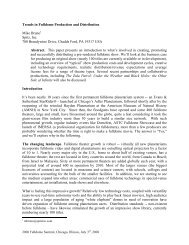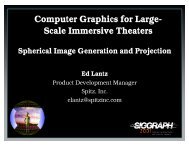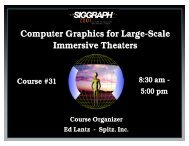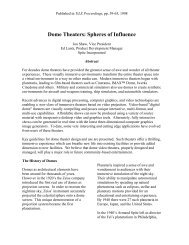Computer Graphics for Large- Scale Immersive Theaters Computer ...
Computer Graphics for Large- Scale Immersive Theaters Computer ...
Computer Graphics for Large- Scale Immersive Theaters Computer ...
You also want an ePaper? Increase the reach of your titles
YUMPU automatically turns print PDFs into web optimized ePapers that Google loves.
<strong>Computer</strong> <strong>Graphics</strong> <strong>for</strong> <strong>Large</strong>-<br />
<strong>Scale</strong> <strong>Immersive</strong> <strong>Theaters</strong><br />
Principles of <strong>Immersive</strong> Imagery<br />
Ben Shedd<br />
Department of <strong>Computer</strong> Science<br />
Princeton University<br />
Shedd Productions, Inc.<br />
benshedd@cs.princeton.edu<br />
Ben Shedd<br />
Principles of <strong>Immersive</strong> Design<br />
Lecture copyright © 1989-2001 Ben Shedd, used by SIGGRAPH 2001 by permission of author. All rights reserved.
Immersion: What’s different?<br />
We - the audience - are inside the<br />
images in immersive theaters.<br />
Ben Shedd<br />
Principles of <strong>Immersive</strong> Design
Immersion: What’s different?<br />
The immersive image is viewed<br />
without a frame. It’s frameless.<br />
Ben Shedd<br />
Principles of <strong>Immersive</strong> Design
The immersion experience is<br />
on the audience’s side of screen,<br />
not up on the screen.<br />
• <strong>Immersive</strong> images mean we can move<br />
our head, which gives us place<br />
feedback.<br />
• We need to provide ways to focus and<br />
point attention, and we need to plan<br />
when the focus is being left open.<br />
Ben Shedd<br />
Principles of <strong>Immersive</strong> Design
Dome screen - planetarium seating<br />
Ben Shedd<br />
Principles of <strong>Immersive</strong> Design<br />
Image Courtesy: Spitz, Inc
Dome screen - stadium seating<br />
Ben Shedd<br />
Principles of <strong>Immersive</strong> Design<br />
Image Courtesy: Spitz, Inc
Inside the image….<br />
<strong>Immersive</strong> productions are frameless!<br />
My experience discovering Framelessness.<br />
• Making a dome film… and discovering the<br />
difference…<br />
• Thinking about the current visual language<br />
based on the frame.<br />
•Rethinking the immersive visual space.<br />
Ben Shedd<br />
Principles of <strong>Immersive</strong> Design
The audience’s view in<br />
immersion is<br />
first-person experience,<br />
not<br />
a second-hand event.<br />
Ben Shedd<br />
Principles of <strong>Immersive</strong> Design
Looking back<br />
to look <strong>for</strong>ward.<br />
Ben Shedd<br />
Principles of <strong>Immersive</strong> Design
Film As Art<br />
by Rudolf Arnheim<br />
University of Cali<strong>for</strong>nia Press<br />
Ben Shedd<br />
Principles of <strong>Immersive</strong> Design<br />
First published in the 1930’s
The Power of the Center<br />
A Study of Composition in the Visual Arts<br />
by Rudolf Arnheim<br />
University of Cali<strong>for</strong>nia Press<br />
Ben Shedd<br />
Principles of <strong>Immersive</strong> Design
The frame of an image has been a<br />
key design element throughout<br />
history.<br />
Everywhere we look, we see framed<br />
images, without seeing the frame.<br />
• Reference: Rudolf Arnheim, The Power of The<br />
Center - University of Cali<strong>for</strong>nia Press 1988<br />
Ben Shedd<br />
Principles of <strong>Immersive</strong> Design
Exploding the Frame<br />
Images in frames are so common that we<br />
don’t notice the frame nor how key it is to<br />
the composition nor the amount of the<br />
image which we are creating in our<br />
imagination.<br />
Here’s a very familiar example …..<br />
Ben Shedd<br />
Principles of <strong>Immersive</strong> Design
Ben Shedd<br />
Principles of <strong>Immersive</strong> Design
Ben Shedd<br />
Principles of <strong>Immersive</strong> Design
Ben Shedd<br />
Principles of <strong>Immersive</strong> Design
Ben Shedd<br />
Principles of <strong>Immersive</strong> Design
Ben Shedd<br />
Principles of <strong>Immersive</strong> Design
Size matters.<br />
SIZE MATTERS!<br />
• No Frame on images means no frame of<br />
reference <strong>for</strong> scale.<br />
• With no frame, the audience is “growing and<br />
shrinking” in relation to the images in the<br />
immersive experience.<br />
Ben Shedd<br />
Principles of <strong>Immersive</strong> Design
Dome screen - planetarium seating<br />
Ben Shedd<br />
Principles of <strong>Immersive</strong> Design<br />
Image Courtesy: Spitz, Inc
Immersion: What’s different?<br />
The immersive image is viewed<br />
without a frame. It’s frameless.<br />
This image has a frame.<br />
In fact, it has two frames.<br />
Ben Shedd<br />
Principles of <strong>Immersive</strong> Design
Immersion: What’s different?<br />
The immersive image is viewed<br />
without a frame. It’s frameless.<br />
This image has a frame.<br />
In fact, it has two frames.<br />
Ben Shedd<br />
Principles of <strong>Immersive</strong> Design
Immersion: What’s different?<br />
The immersive image is viewed<br />
without a frame. It’s frameless.<br />
This image has a frame.<br />
In fact, it has two frames.<br />
Now it only has the<br />
projector frame frame.
Ben Shedd<br />
Principles of <strong>Immersive</strong> Design
L’ECRAN TOTAL<br />
pour un cinéma sphérique<br />
by Philippe Jaulmes<br />
Cinema Futur<br />
Ben Shedd<br />
Principles of <strong>Immersive</strong> Design
Immersion/Framelessness:<br />
What are the implications?<br />
“You are there”<br />
“It is here”<br />
“We are together”<br />
Concepts from:<br />
At the Heart of the Matter: The Study of Presence<br />
by Matthew Lombard and Theresa Ditton<br />
Ben Shedd<br />
Principles of <strong>Immersive</strong> Design
Immersion/Framelessness:<br />
What are the implications?<br />
“We are moving”<br />
“We are growing and shrinking”<br />
“We are the main character<br />
in the story”<br />
Ben Shedd<br />
Principles of <strong>Immersive</strong> Design<br />
Concepts from:<br />
Exploding The Frame<br />
by Ben Shedd
Immersion:<br />
A TOOLBOX FOR<br />
EFFECTIVE PRODUCTION<br />
Ben Shedd<br />
Principles of <strong>Immersive</strong> Design
The audience has no clue of<br />
the projection technology.<br />
Many immersive projection systems are<br />
multi-projector, tiled systems.<br />
• The audience will not understand<br />
unintentional frames projected within<br />
the immersive space.<br />
• Reference: Rudolf Arnheim, Motion - 1934, Film<br />
As Art. University of Cali<strong>for</strong>nia Press 1957<br />
Ben Shedd<br />
Principles of <strong>Immersive</strong> Design
Most all of the production tools<br />
have frames.<br />
The common working tools:<br />
• The storyboard images have frames.<br />
• The cameras have frames.<br />
• The desktop computer design and<br />
editing machines have frames.<br />
Ben Shedd<br />
Principles of <strong>Immersive</strong> Design
The Audience is immersed inside<br />
the image and inside the frame.<br />
The challenge: All the production tools<br />
show images inside a frame, 180°<br />
opposite to how the audience will<br />
experience the immersion events.<br />
•Make or find a fisheye viewfinder.<br />
•Mark the design and editing table frame.<br />
Ben Shedd<br />
Principles of <strong>Immersive</strong> Design
The Audience is immersed inside<br />
the image and inside the frame.<br />
•Make or find a fisheye viewfinder.<br />
Ben Shedd<br />
Principles of <strong>Immersive</strong> Design
• Mark the design and editing table frame.<br />
Ben Shedd<br />
Principles of <strong>Immersive</strong> Design
The Audience is immersed inside<br />
the image and inside the frame.<br />
The challenge - part 2: All of us are<br />
habituated to seeing images inside<br />
frames. Expert production crews are<br />
experts at using frames.<br />
•How to explode the creative parameters<br />
<strong>for</strong> the crew? How to immerse the crew?<br />
•Get in the theater as often as possible.<br />
Ben Shedd<br />
Principles of <strong>Immersive</strong> Design
The Audience is moving.<br />
The challenge: With no frame, any image<br />
movement is perceived as audience<br />
movement in the opposite direction.<br />
• Track start and stop movements in a shot.<br />
• Track the sense of movement from shot to<br />
shot. How does the audience move?<br />
Ben Shedd<br />
Principles of <strong>Immersive</strong> Design
The Audience is growing<br />
and shrinking.<br />
The challenge: With no frame of reference,<br />
the sensation of size change is a direct<br />
experience <strong>for</strong> the audience.<br />
• Pace <strong>for</strong> this cognitive sensation.<br />
• Design the action as events on the<br />
audience’s side of the screen.<br />
Ben Shedd<br />
Principles of <strong>Immersive</strong> Design
The Audience is directly<br />
experiencing the scale of things.<br />
The challenge: With no frame, any image is<br />
perceived as a one to one experience.<br />
• Track the scale of objects within an image.<br />
• Track the scale represented from image to<br />
image. How does the audience track it?<br />
Ben Shedd<br />
Principles of <strong>Immersive</strong> Design
Movement needs continuity.<br />
It is a first person experience <strong>for</strong> the<br />
audience.<br />
• The audience seems to be moving.<br />
• The theater seems to be moving.<br />
• Movement within images must tie together<br />
as they are strung together.<br />
Ben Shedd<br />
Principles of <strong>Immersive</strong> Design
<strong>Scale</strong> needs continuity.<br />
It is a first person experience <strong>for</strong> the<br />
audience.<br />
• The audience seems to be growing and<br />
shrinking.<br />
• <strong>Scale</strong> within images and between images<br />
must tie together as they play out.<br />
Ben Shedd<br />
Principles of <strong>Immersive</strong> Design
The images appear on<br />
a curved screen.<br />
The challenge: You can’t get around the<br />
fact that the screen surface is curved and<br />
the image is annealed onto that surface.<br />
• Optimize in circular patterns from center.<br />
• Optimize <strong>for</strong> majority of seats. How does the<br />
audience track it?<br />
Ben Shedd<br />
Principles of <strong>Immersive</strong> Design
Photo depth of field<br />
sharpness decreases with<br />
increase in image size.<br />
The challenge: For photographic images,<br />
the amount of apparent focus in the depth<br />
of field is inversely proportional to the<br />
size of the screen.<br />
• Use lens charts to determine fine focus.<br />
• See the image projected on the full screen.<br />
Ben Shedd<br />
Principles of <strong>Immersive</strong> Design
Continuity provided by<br />
music and sound.<br />
The challenge: Music written to frameless<br />
images can be very amusical.<br />
• The sound is not 50%/50% with picture, but<br />
the whole is an 100% experience.<br />
• Musical patterns can provide wonderful<br />
anticipation and release. Edit to music.<br />
Ben Shedd<br />
Principles of <strong>Immersive</strong> Design
Write final narration to the pictures.<br />
• See what the audience is seeing and write<br />
directly from what we are seeing.<br />
• Let the audience have time to observe and<br />
experience <strong>for</strong> ourselves. It’s a visceral<br />
experience. Give the audience time to feel.<br />
Ben Shedd<br />
Principles of <strong>Immersive</strong> Design
The screen is essentially a huge<br />
black space, a vast “negative space.”<br />
• It is not necessary to fill the whole screen all<br />
the time.<br />
• The shift in image size against black provides<br />
another tool <strong>for</strong> provoking and promoting<br />
AWE in the viewers.<br />
• Open and close the screen size deliberately.<br />
Ben Shedd<br />
Principles of <strong>Immersive</strong> Design
The audience’s view in<br />
immersion is<br />
first-person experience,<br />
not a second-hand event.<br />
Ben Shedd<br />
Principles of <strong>Immersive</strong> Design
We are immersed within<br />
the experience.<br />
The immersive<br />
experience is viewed<br />
without a frame.<br />
It’s frameless.<br />
Ben Shedd<br />
Principles of <strong>Immersive</strong> Design
Ben Shedd<br />
Principles of <strong>Immersive</strong> Design
References: Essays on <strong>Immersive</strong><br />
Ben Shedd<br />
Principles of <strong>Immersive</strong> Design<br />
Design By Ben Shedd<br />
Exploding The Frame<br />
http://www.cs<br />
cs.princeton.edu/~<br />
/~benshedd/ExplodingtheFrame.htmhtm<br />
Designing <strong>for</strong> the Dome<br />
http://members.aol<br />
aol.com/sheddprod2/papers.html#the%20Dome<br />
Designing Effective Giant Screen Films<br />
http://members.aol<br />
aol.com/sheddprod2/papers.html#Designing
References: Books and Papers<br />
The Power of the Center by Rudolf Arnheim<br />
University of Cali<strong>for</strong>nia Press 1988<br />
Film As Art by Rudolf Arnheim<br />
University of Cali<strong>for</strong>nia Press 1957<br />
L’ECRAN TOTAL pour un cinéma sphérique<br />
by<br />
Philippe Jaulmes. . Cinema Futur Paris Lherminier<br />
1981<br />
At the Heart of the Matter: The Study of Presence by<br />
Matthew Lombard & Theresa Ditton<br />
http://www.ascusc<br />
ascusc.org/ .org/jcmc/vol3/issue2/lombard.html<br />
Ben Shedd<br />
Principles of <strong>Immersive</strong> Design
References: Books and Papers<br />
The Production of Voyage to the Outer Planets. By George<br />
Casey. American Cinematographer magazine. August<br />
1973<br />
The Filming of “Ocean” in Omnimax. Interview with<br />
Graeme Ferguson and William Shaw. American<br />
Cinematographer October 1977.<br />
Imax and Omnimax Theatre Design. By William C.<br />
Shaw and J. Douglas Creighton. . SMPTE Journal March<br />
1983.<br />
Ben Shedd<br />
Principles of <strong>Immersive</strong> Design
References: Books and Papers<br />
Criteria <strong>for</strong> Motion-Picture Viewing and <strong>for</strong> a New 70mm<br />
System: Its Process and Viewing Arrangements. By<br />
Ben Schlanger. . SMPTE Journal March 1966.<br />
American Cinematographer Manual. Charles G. Clarke<br />
ASC and Walter Strenge ASC, Editors;, American Society<br />
of Cinematographers, Hollywood, CA 4th Ed. c. 1973.<br />
Ben Shedd<br />
Principles of <strong>Immersive</strong> Design
References: Books and Papers<br />
Building and Using A Scalable Display Wall System<br />
Authors: Kai Li, , Han Chen, Yuqun Chen, Douglas W. Clark,<br />
Perry Cook, Stefanos Damianakis, Georg Essl, , Adam<br />
Finkelstein, , Thomas Funkhouser, , Timothy Housel, , Allison<br />
Klein, Zhiyan Liu, Emil Praun, Rudrajit Samanta, , Ben<br />
Shedd, Jaswinder Pal Singh, George Tzanetakis,and<br />
Jiannan Zheng.<br />
IEEE <strong>Computer</strong> <strong>Graphics</strong> & Applications, Vol. . 20, No. 4,<br />
July/August 2000<br />
Ben Shedd<br />
Principles of <strong>Immersive</strong> Design
<strong>Immersive</strong> displays:<br />
Exploding The Frame<br />
• This frameless research was supported by an<br />
Alden B. Dow Creativity Center Residential<br />
Fellowship, a grant from the Science Museum of<br />
Minnesota, and a conference grant from the<br />
National Science Foundation.<br />
• Ben Shedd is a Senior Research Scholar &<br />
Lecturer in the Department of <strong>Computer</strong> Science,<br />
Princeton University, and owner of Shedd<br />
Productions, Inc.<br />
Ben Shedd<br />
Principles of <strong>Immersive</strong> Design
















